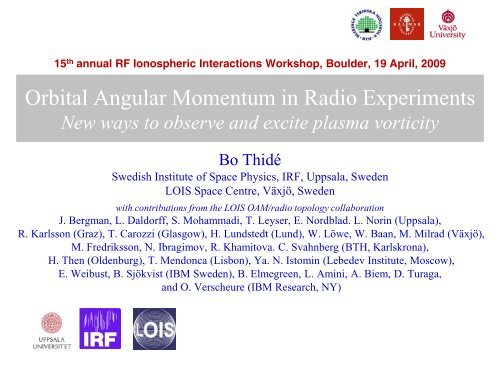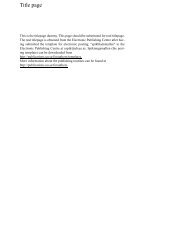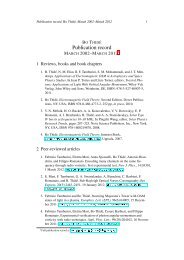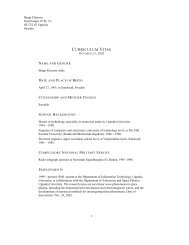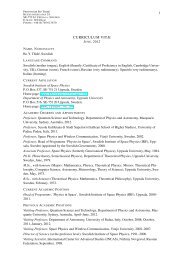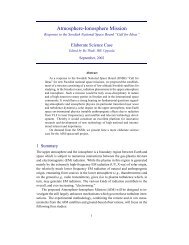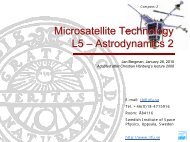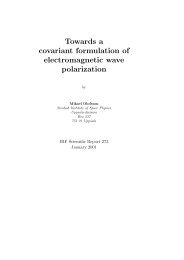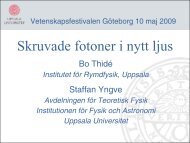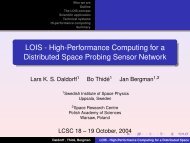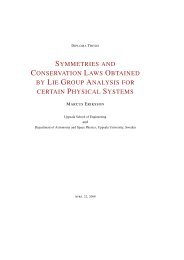Orbital Angular Momentum in Radio Experiments - Swedish Institute ...
Orbital Angular Momentum in Radio Experiments - Swedish Institute ...
Orbital Angular Momentum in Radio Experiments - Swedish Institute ...
Create successful ePaper yourself
Turn your PDF publications into a flip-book with our unique Google optimized e-Paper software.
15 th annual RF Ionospheric Interactions Workshop, Boulder, 19 April, 2009<br />
<strong>Orbital</strong> <strong>Angular</strong> <strong>Momentum</strong> <strong>in</strong> <strong>Radio</strong> <strong>Experiments</strong><br />
New ways to observe and excite plasma vorticity<br />
Bo Thidé<br />
<strong>Swedish</strong> <strong>Institute</strong> of Space Physics, IRF, Uppsala, Sweden<br />
LOIS Space Centre, Växjö, Sweden<br />
with contributions from the LOIS OAM/radio topology collaboration<br />
J. Bergman, L. Daldorff, S. Mohammadi, T. Leyser, E. Nordblad. L. Nor<strong>in</strong> (Uppsala),<br />
R. Karlsson (Graz), T. Carozzi (Glasgow), H. Lundstedt (Lund), W. Löwe, W. Baan, M. Milrad (Växjö),<br />
M. Fredriksson, N. Ibragimov, R. Khamitova. C. Svahnberg (BTH, Karlskrona),<br />
H. Then (Oldenburg), T. Mendonca (Lisbon), Ya. N. Istom<strong>in</strong> (Lebedev <strong>Institute</strong>, Moscow),<br />
E. Weibust, B. Sjökvist (IBM Sweden), B. Elmegreen, L. Am<strong>in</strong>i, A. Biem, D. Turaga,<br />
and O. Verscheure (IBM Research, NY)
SEE as an on-demand space plasma EM<br />
turbulence diagnostics<br />
Complements – and supplements – optics, radars, satellites,etc.<br />
BoThidé 15th annual RF Ionospheric Interactions Workshop, Boulder, 20 April, 2009<br />
2
Secondary HF radio emission dependence<br />
on primary HF radio frequency ce<br />
HF pump frequency swept cont<strong>in</strong>uously up and down across 4f at Sura, Russia<br />
BUM hysteresis<br />
HF excited secondary radiation (SEE) as recorded at the radio facility SURA near Nizhniy Novgorod,<br />
Russia, 1999. The HF pump frequency is swept across the ionospheric 4 th electron gyroharmonic.<br />
Pump<br />
60 kHz <br />
(Click for animation)<br />
4f<br />
5340 kHz ce<br />
5540 kHz<br />
BoThidé 15th annual RF Ionospheric Interactions Workshop, Boulder, 20 April, 2009<br />
3
First detection of angular momentum <strong>in</strong> SEE<br />
<strong>Experiments</strong> at HEATING, Tromsø, 1983<br />
Bo Thidé. Stimulated Electromagnetic Emission and nonl<strong>in</strong>ear wave-wave <strong>in</strong>teractions <strong>in</strong><br />
ionospheric heat<strong>in</strong>g experiments. In M. Q. Tran and M. L. Sawley, editors, Proceed<strong>in</strong>gs,<br />
Contributed Papers, International Conference on Plasma Physics, volume I, page 131,<br />
Lausanne, Switzerland, 27 June-3 July 1984. Centre de Recherche en Physique des<br />
Plasmas, Ecole Polytechnique Federal de Lausanne, CRPP-EPFL.<br />
Circular, (nearly) O-mode pump<strong>in</strong>g<br />
O mode SEE<br />
X mode SEE<br />
Bo Thidé 15th annual RF Ionospheric Interactions Workshop, Boulder, 20 April, 2009<br />
4
First full polarimetry studies of SEE<br />
<strong>Experiments</strong> at SURA,Vasil’sursk, September 1998<br />
Bo Thidé 15th annual RF Ionospheric Interactions Workshop, Boulder, 20 April, 2009<br />
5
Lorentz’s microscopic Maxwell equations<br />
for the EM field (1903)<br />
Symmetric under <strong>in</strong>homogeneous Lorentz transformations. The concomitant Lie<br />
group is the 10-dimensional Po<strong>in</strong>caré group P(10). Accord<strong>in</strong>g to Noether’s<br />
theorem there therefore exist 10 conserved EM quantities. In fact there are 25<br />
exact cont<strong>in</strong>uous symmetries/conserved quantities (<strong>in</strong> vacuo), plus an as yet<br />
unknown number of approximate, conservation laws [Ibragimov, 2008].<br />
Bo Thidé 15th annual RF Ionospheric Interactions Workshop, Boulder, 20 April, 2009<br />
6
Conserved quantities <strong>in</strong> a closed electromechanical<br />
system (matter + EM fields) [Boyer, 2005] (1)<br />
Homogeneity <strong>in</strong> time => conservation of system energy<br />
(no EMF, no radiation; cf. Poynt<strong>in</strong>g’s theorem):<br />
Homogeneity <strong>in</strong> space => conservation of system l<strong>in</strong>ear<br />
momentum (gives, e.g., rise to EM Doppler shift):<br />
Foundation of conventional ‘l<strong>in</strong>ear momentum’ radio.<br />
Bo Thidé 15th annual RF Ionospheric Interactions Workshop, Boulder, 20 April, 2009<br />
7
Conserved quantities <strong>in</strong> a closed electromechanical<br />
system (matter + EM fields) [Boyer, 2005] (2)<br />
Invariance under proper Lorentz transformations =><br />
conservation of system centre of energy:<br />
Isotropy <strong>in</strong> space => conservation of system angular<br />
momentum (gives rise to azimuthal Doppler shift):<br />
The first part is the mechanical angular momentum J mech .<br />
The second part is the EM angular momentum J em .<br />
Foundation of ‘angular momentum’ radio or ‘dual radio’.<br />
Bo Thidé 15th annual RF Ionospheric Interactions Workshop, Boulder, 20 April, 2009<br />
8
Total EM field angular momentum<br />
For radiation beams <strong>in</strong> free space, EM field angular momentum J em can<br />
be separated <strong>in</strong>to two parts (for x 0 = 0) [Jackson, 1998; Thidé, 2009]:<br />
For each s<strong>in</strong>gle Fourier mode <strong>in</strong> real-valued representation [van Enk &<br />
Nienhuis, 1992]:<br />
The first part is the EM sp<strong>in</strong> angular momentum (SAM) S em , a.k.a. wave<br />
polarisation, and the second part is the EM orbital angular momentum<br />
(OAM) L em .<br />
NB: In general, both EM l<strong>in</strong>ear momentum p em , and EM angular<br />
momentum J em = L em + S em are radiated all the way out to the far zone!<br />
Bo Thidé 15th annual RF Ionospheric Interactions Workshop, Boulder, 20 April, 2009<br />
9
Standard textbooks show that classical<br />
EM angular momentum is radiated<br />
all the way to <strong>in</strong>f<strong>in</strong>ity<br />
Bo Thidé 15th annual RF Ionospheric Interactions Workshop, Boulder, 20 April, 2009<br />
10
Difference between polarisation (SAM) and orbital<br />
angular momentum (OAM)<br />
Bo Thidé 15th annual RF Ionospheric Interactions Workshop, Boulder, 20 April, 2009<br />
11
Micromechanical action of SAM and OAM<br />
Particles of sizes 1–3 μm irradiated by SAM/OAM laser beams<br />
Sp<strong>in</strong> angular momentum s = 1 <strong>Orbital</strong> angular momentum l = 8<br />
Bo Thidé 15th annual RF Ionospheric Interactions Workshop, Boulder, 20 April, 2009<br />
12
Challenge: Ionospheric and atmospheric turbulence<br />
distort low-frequency radio signals from outer space<br />
Today it is possible to compensate (‘self-calibrate’) for amplitude and nons<strong>in</strong>gular<br />
phase distortion of signals propagation through the ionosphere. Data<br />
from observations at VLA (Very Large Array, NM, USA) at 74 MHz.<br />
Bo Thidé 15th annual RF Ionospheric Interactions Workshop, Boulder, 20 April, 2009<br />
13
Phase s<strong>in</strong>gularities (dislocations) are to be expected<br />
<strong>in</strong> radio beams propagat<strong>in</strong>g through space<br />
Bo Thidé 15th annual RF Ionospheric Interactions Workshop, Boulder, 20 April, 2009<br />
14
Impart<strong>in</strong>g OAM onto an EM beam (laser, mm wave)<br />
with the help of a spiral plate or hologram<br />
Bo Thidé 15th annual RF Ionospheric Interactions Workshop, Boulder, 20 April, 2009<br />
15
Prediction: Ionospheric and other space plasma<br />
turbulence can change the topology of radio signals<br />
Bo Thidé 15th annual RF Ionospheric Interactions Workshop, Boulder, 20 April, 2009<br />
16
Plasma vorticity couples to radio<br />
OAM => topological distortion<br />
PRL<br />
NPG<br />
Bo Thidé 15th annual RF Ionospheric Interactions Workshop, Boulder, 20 April, 2009<br />
17
Nonl<strong>in</strong>ear excitation of OAM <strong>in</strong> plasma<br />
PRL, <strong>in</strong> press<br />
Bo Thidé 15th annual RF Ionospheric Interactions Workshop, Boulder, 20 April, 2009<br />
18
Even neutr<strong>in</strong>o beams can be endowed with OAM!<br />
Bo Thidé 15th annual RF Ionospheric Interactions Workshop, Boulder, 20 April, 2009<br />
19
EM beam with circular polarisation (SAM) S but<br />
no orbital angular momentum (POAM) L<br />
Phase fronts (loci of constant phase)<br />
Optics (LG)<br />
<strong>Radio</strong><br />
M. J. Padgett, J. Leach et al., U. Glasgow, UK; Royal Society<br />
Sjöholm and Palmer, 2007<br />
Bo Thidé 15th annual RF Ionospheric Interactions Workshop, Boulder, 20 April, 2009<br />
20
Instantaneous field vectors across an antenna<br />
array for a radio beam with circular SAM<br />
Phase 0 deg<br />
Phase 45 deg<br />
Bo Thidé 15th annual RF Ionospheric Interactions Workshop, Boulder, 20 April, 2009<br />
21
EM beams on the same frequency but with different OAM<br />
would be orthogonal and not <strong>in</strong>terfere with each other<br />
Spiral<strong>in</strong>g Poynt<strong>in</strong>g/l<strong>in</strong>ear momentum (and OAM) vectors!<br />
l=+1<br />
l=+3<br />
l= -4<br />
Bo Thidé 22
Instantaneous field vectors <strong>in</strong> a cross section of<br />
a radio beam carry<strong>in</strong>g both SAM and OAM<br />
Phase 0 deg<br />
Phase 45 deg<br />
Bo Thidé 15th annual RF Ionospheric Interactions Workshop, Boulder, 20 April, 2009<br />
23
Three orthogonal dipole antennas sample E(t,x)<br />
Three orthogonal loop antennas sample B(t,x)<br />
Bo Thidé 15th annual RF Ionospheric Interactions Workshop, Boulder, 20 April, 2009<br />
24
3D vector antennas allow new types of diagnostics<br />
Bo Thidé 15th annual RF Ionospheric Interactions Workshop, Boulder, 20 April, 2009<br />
25
LOIS radio idea: Sample the entire field vectors <strong>in</strong><br />
time and space (LOIS stn true superset of LOFAR stn)<br />
Bo Thidé 15th annual RF Ionospheric Interactions Workshop, Boulder, 20 April, 2009<br />
26
LOIS resources 2003–today (total ~ 2.5 MEur)<br />
Computer cluster (two SUR grants from IBM),<br />
currently <strong>in</strong> Uppsala. To be moved to Ronneby<br />
The control room at the LOIS Test Station Ris<strong>in</strong>ge/Växjö.<br />
<strong>Radio</strong> Sweden’s 500 kW transmitter located about<br />
100 km south of the Växjö LOIS test station and<br />
100 km south-west of the Ronneby prototype<br />
station site. Will be used for space radar tests.<br />
9m×8m×6m antenna chamber,<br />
Ångström Lab, Uppsala<br />
Magnetometer, LOIS Test<br />
Station, Ris<strong>in</strong>ge/Växjö<br />
Bo Thidé 15th annual RF Ionospheric Interactions Workshop, Boulder, 20 April, 2009<br />
27
LOIS prototype station under construction <strong>in</strong> Ronneby<br />
To be augmented by two outer, concentric r<strong>in</strong>gs, with 16 and 32 radio units,<br />
respectively, for a total of 56 units with three dipoles each (fund<strong>in</strong>g permitt<strong>in</strong>g)<br />
Bo Thidé 15th annual RF Ionospheric Interactions Workshop, Boulder, 20 April, 2009<br />
28
Mechanical effects of EM orbital angular momentum<br />
(OAM) predicted 1992<br />
Beth’s experiment, 1936<br />
Bo Thidé 15th annual RF Ionospheric Interactions Workshop, Boulder, 20 April, 2009<br />
29
<strong>Radio</strong> beams from circular antenna arrays<br />
can be made to carry OAM!<br />
Thidé et al., Phys. Rev. Lett., 99, 087701, 2007<br />
Bo Thidé 15th annual RF Ionospheric Interactions Workshop, Boulder, 20 April, 2009<br />
30
Field vector sens<strong>in</strong>g means total configurability<br />
Very good solar radio coronagraph!<br />
Bo Thidé 15th annual RF Ionospheric Interactions Workshop, Boulder, 20 April, 2009<br />
31
<strong>Radio</strong> beam topology degrees of freedom<br />
Conventional l<strong>in</strong>ear momentum (Poynt<strong>in</strong>g) flux and E<br />
Bo Thidé 15th annual RF Ionospheric Interactions Workshop, Boulder, 20 April, 2009<br />
32
The radio results agree with EM OAM theory<br />
Theory predicts that a circular polarised radio beam <strong>in</strong> a pure<br />
OAM eigenstate with azimuthal phase dependence exp(ilφ),<br />
frequency ω, and energy H, should have a total angular<br />
momentum component J z<br />
EM<br />
= lH/ω along the z (beam) axis.<br />
Bo Thidé 15th annual RF Ionospheric Interactions Workshop, Boulder, 20 April, 2009<br />
33
LOIS prototype station sensitivity<br />
48 tripoles=144 dipoles<br />
Bo Thidé 15th annual RF Ionospheric Interactions Workshop, Boulder, 20 April, 2009<br />
34
Very readable paper on POAM <strong>in</strong> astrophysics<br />
Bo Thidé 15th annual RF Ionospheric Interactions Workshop, Boulder, 20 April, 2009<br />
35
POAM <strong>in</strong> astronomy – A very recent and very<br />
comprehensive treatise<br />
Bo Thidé 15th annual RF Ionospheric Interactions Workshop, Boulder, 20 April, 2009<br />
36
2D LOFAR/SKA-type <strong>in</strong>terferometers exhibit<br />
polarisation aberration. 3D <strong>in</strong>terferometers do not<br />
Bo Thidé 15th annual RF Ionospheric Interactions Workshop, Boulder, 20 April, 2009<br />
37
Europe is lead<strong>in</strong>g the way<br />
Bo Thidé 15th annual RF Ionospheric Interactions Workshop, Boulder, 20 April, 2009<br />
38
Observations at 94 GHz of angular momentum<br />
<strong>in</strong>duced azimuthal (rotational ) Doppler shift<br />
Bo Thidé 15th annual RF Ionospheric Interactions Workshop, Boulder, 20 April, 2009<br />
39
Rotational Doppler shift spectrum<br />
Bo Thidé 15th annual RF Ionospheric Interactions Workshop, Boulder, 20 April, 2009<br />
40
Deep space radar requirements<br />
From Paul Rodriguez<br />
Bo Thidé 15th annual RF Ionospheric Interactions Workshop, Boulder, 20 April, 2009<br />
41
OAM spectrum prob<strong>in</strong>g (spiral imag<strong>in</strong>g) – a<br />
new radar diagnostic<br />
Recent digital spiral imag<strong>in</strong>g experiments (Ll. Torner et al., Opt. Express, 13, 873–881, 2005;<br />
Mol<strong>in</strong>a-Terriza et al., J. Eur. Opt. Soc., Rapid Publ., 2, 07014, 2007) have demonstrated that<br />
prob<strong>in</strong>g with OAM gives a wealth of new <strong>in</strong>formation about the object under study.<br />
The stimulus…<br />
Bo Thidé 15th annual RF Ionospheric Interactions Workshop, Boulder, 20 April, 2009<br />
42
Spiral (OAM) spectrum imag<strong>in</strong>g results<br />
…and its response<br />
Bo Thidé 15th annual RF Ionospheric Interactions Workshop, Boulder, 20 April, 2009<br />
43
OAM detection of <strong>in</strong>homogeneities (<strong>in</strong> transmission)<br />
Bo Thidé 15th annual RF Ionospheric Interactions Workshop, Boulder, 20 April, 2009<br />
44
EM vorticity/OAM as turbulence diagnostic<br />
Bo Thidé 15th annual RF Ionospheric Interactions Workshop, Boulder, 20 April, 2009<br />
45
OAM makes a new (spiral) frequency Ω available<br />
Interest<strong>in</strong>g consequences for radio communications<br />
Bo Thidé 15th annual RF Ionospheric Interactions Workshop, Boulder, 20 April, 2009<br />
46
S<strong>in</strong>gle photons can carry both sp<strong>in</strong> angular<br />
momentum S and orbital angular momentum L!<br />
Bo Thidé 15th annual RF Ionospheric Interactions Workshop, Boulder, 20 April, 2009<br />
47
Pack EM beams with much more data by<br />
utilis<strong>in</strong>g more topological degrees of freedom<br />
Bo Thidé 15th annual RF Ionospheric Interactions Workshop, Boulder, 20 April, 2009<br />
48
Hyperentangled SAM and OAM photon states break<br />
the l<strong>in</strong>ear-optics channel capacity threshold<br />
Bo Thidé 15th annual RF Ionospheric Interactions Workshop, Boulder, 20 April, 2009<br />
49
Shannon’s law revisited<br />
Bo Thidé 15th annual RF Ionospheric Interactions Workshop, Boulder, 20 April, 2009<br />
50
Photon OAM for observ<strong>in</strong>g black holes?<br />
Bo Thidé 15th annual RF Ionospheric Interactions Workshop, Boulder, 20 April, 2009<br />
51
New ideas – new audiences. SETI?<br />
‘…The <strong>in</strong>vestigation of new<br />
transmission modes by Thidé and<br />
Bergman h<strong>in</strong>ts that if we do f<strong>in</strong>d a<br />
signal from ET, we may wish to<br />
reconfigure our radio telescopes to<br />
look for encod<strong>in</strong>g of the message via<br />
such subtle effects as orbital angular<br />
momentum. A simple signal may only<br />
be a cipher for a more complex<br />
message, and there may be more<br />
th<strong>in</strong>gs <strong>in</strong> heaven and earth than even<br />
Maxwell had dreamt of …’<br />
Bo Thidé 15th annual RF Ionospheric Interactions Workshop, Boulder, 20 April, 2009<br />
52
Conclusions<br />
• Us<strong>in</strong>g all ‘degrees of freedom’ (conserved quantities)<br />
allows full characterization and extraction of all<br />
<strong>in</strong>formation carried by beams of EM waves/photons<br />
• Has already provided better diagnostics <strong>in</strong> laser<br />
physics and is enter<strong>in</strong>g free-space communications<br />
• Can use conventional radio techniques to apply these<br />
new results to the radio doma<strong>in</strong><br />
• The radio doma<strong>in</strong> results hold great promise for new<br />
fundamental optics and improved remote diagnostics<br />
• World’s first (?) OAM radio laboratory at Ångström<br />
Lab, Uppsala, is now com<strong>in</strong>g on l<strong>in</strong>e<br />
Bo Thidé 15th annual RF Ionospheric Interactions Workshop, Boulder, 20 April, 2009<br />
53
Thank you for your attention<br />
....there may be more th<strong>in</strong>gs <strong>in</strong> heaven and earth than even Maxwell had dreamt of …<br />
Bo Thidé 15th annual RF Ionospheric Interactions Workshop, Boulder, 20 April, 2009<br />
54
New ideas – detection of magnetic monopoles by<br />
measur<strong>in</strong>g the symmetry properties of the EM field?<br />
Bo Thidé 15th annual RF Ionospheric Interactions Workshop, Boulder, 20 April, 2009<br />
55
Radiation of power/l<strong>in</strong>ear momentum vs.<br />
radiation of angular momentum<br />
Outside (but not <strong>in</strong>side) the source<br />
region, the fields can be accurately<br />
approximated by an expansion <strong>in</strong><br />
spherical waves:<br />
The approximation (2) of approximation (1) is<br />
excellent for radiation of l<strong>in</strong>ear momentum<br />
(power, Poynt<strong>in</strong>g flux) but is completely<br />
wrong for radiation of angular momentum.<br />
The E R term excluded is the only term which<br />
gives rise to radiation of angular momentum!<br />
Bo Thidé 15th annual RF Ionospheric Interactions Workshop, Boulder, 20 April, 2009<br />
56
That far-zone POAM is generated by near-zone<br />
longitud<strong>in</strong>al E fields is well known s<strong>in</strong>ce 1914<br />
Bo Thidé 15th annual RF Ionospheric Interactions Workshop, Boulder, 20 April, 2009<br />
57
Sp<strong>in</strong>-off LOIS developments for space physics,<br />
astroparticle physics, and space communications<br />
Vector sens<strong>in</strong>g radio on a chip, 33×33 mm 2<br />
at 4 grammes based on bare die<br />
components on silicon<br />
Vector radio system for detection of<br />
UHE neutr<strong>in</strong>o <strong>in</strong>duced radio pulses <strong>in</strong><br />
the Antarctic ice<br />
Bo Thidé 15th annual RF Ionospheric Interactions Workshop, Boulder, 20 April, 2009<br />
58
LOIS physics idea: Space physics, space weather,<br />
solar radar, ionospheric turbulence ...<br />
Download from www.lois-space.net<br />
Bo Thidé 15th annual RF Ionospheric Interactions Workshop, Boulder, 20 April, 2009<br />
59


